Table of Contents
Oranges
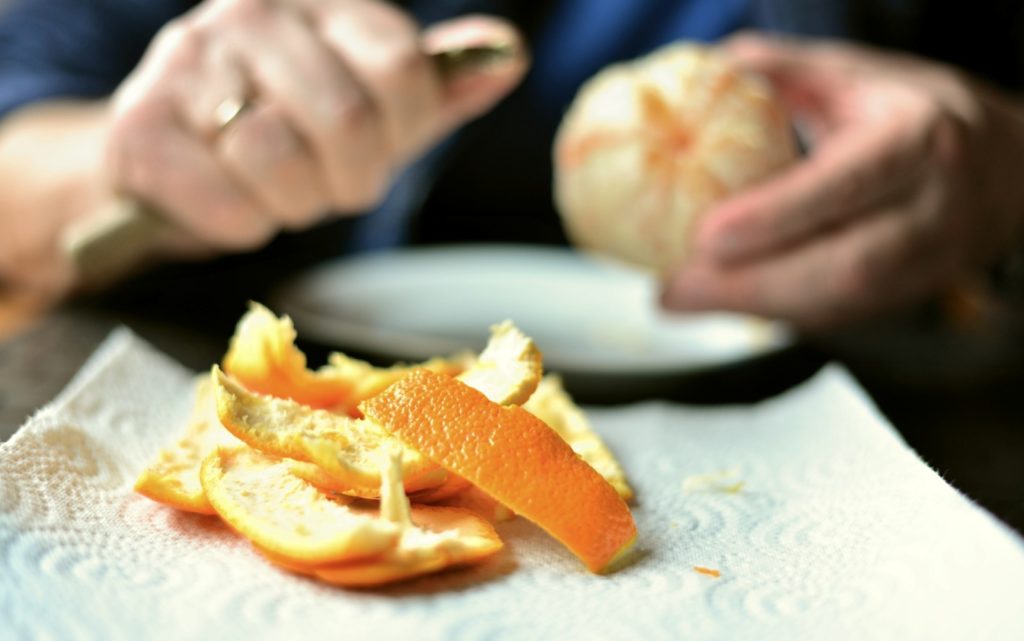
If you are having an orange, do you do anything with the peel, the pith or the pips?
Zest
If I am just having an orange to eat, I’ll often zest it into a small container that I keep in the freezer for the purpose. That zest can then be used for all kinds of things. Or sometimes, now, I pop the entire peel in the freezer
Peel
Well, I’ve found the peel from an orange is valuable resource! When you eat an orange, keep the peel. Pop it into the freezer until you have enough to use for something, or until you have enough time to use it.
Orange Sugar
Finely mix 4 tblsps sugar with orange peel in a blender. Then use this to sprinkle on pancakes, ice cream and other puddings
Candied Orange Peels
Or you can use the peel to make candied orange peels
The second life of an orange: candied orange peels, the Italian way
Infused Olive Oil
Make an AMAZING infused olive oil
Orange Bread
If you have a whole cup of zest accumulated in the freezer, use your leftover citrus to make this wonderful Orange Bread
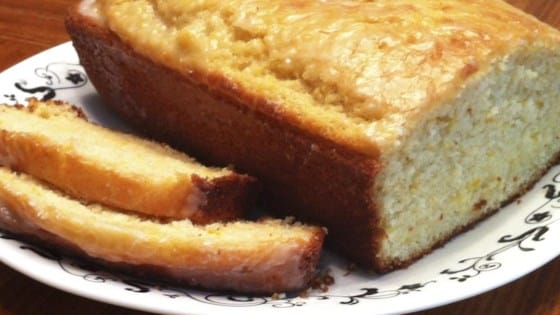
Dried Orange Peel
Dried orange peel makes a delicious, piquant addition to a wide variety of both savory and sweet dishes. It’s very easy to make your own at home and it has much more flavor than the bought variety.
Pot Pourri
Or how about an Autumn Pot Pourri using your leftover orange peels?
Orange Oil Extract
Would you like to know how to make an orange oil extract?
Orange Cleaning Spray
Or how about an orange cleaning spray? I soaked some orange carcasses in white vinegar for a month, shaking it every day or so. Then strained out the peel and put in a spray bottle
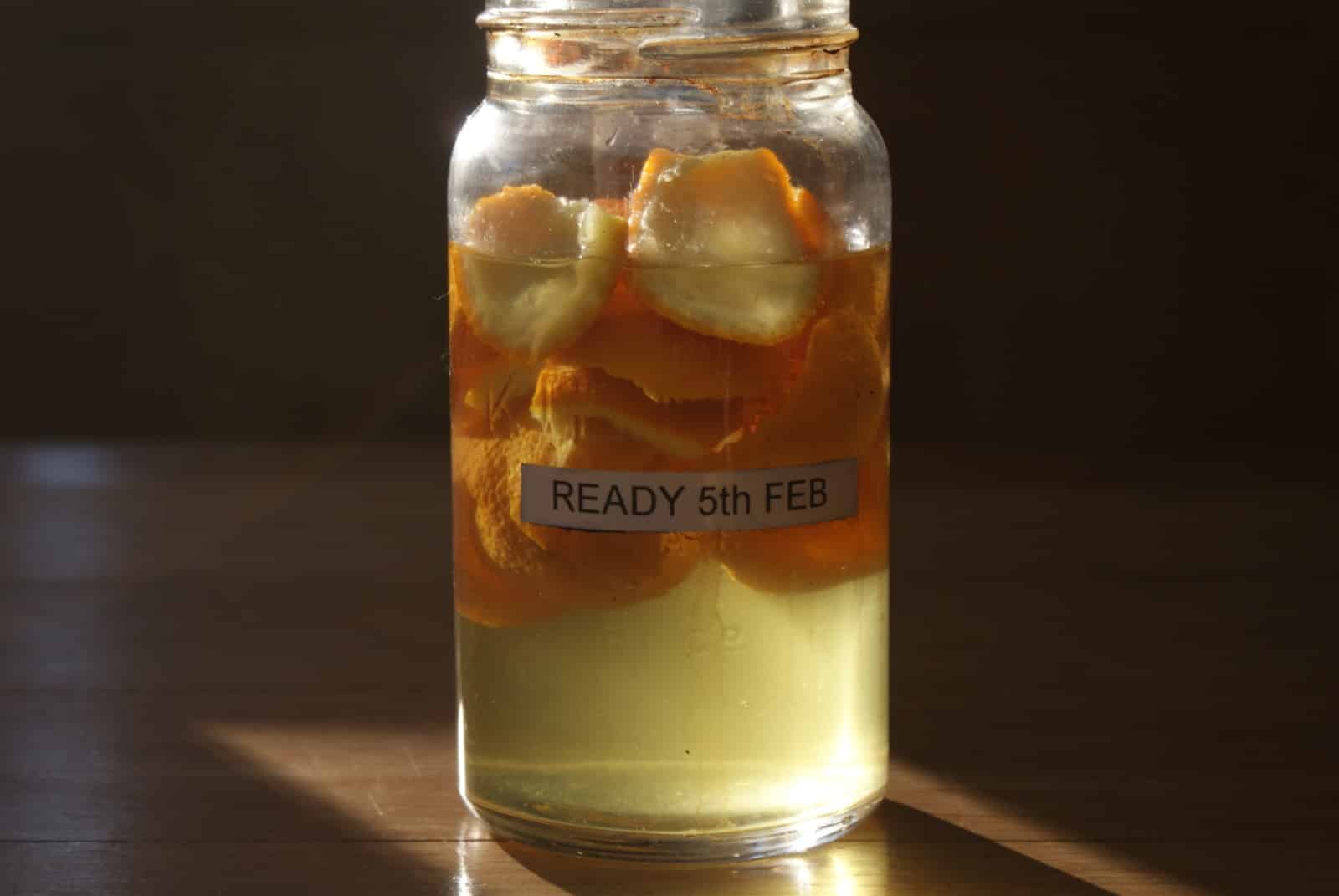
Orange peel soaking in white vinegar to make a cleaning spray – it smells wonderful!
Whole Orange Cake
If you have a whole orange to use, this gorgeous whole orange cake is the business
Lemons
I have discovered that there is absolutely no part of a lemon that need go to waste – zest, peel, flesh, pith and even the pips can be used. Well perhaps the flower stalk on the end, even that goes in the compost, so is not completely wasted!
Puréed Citrus Carcass
I discovered the amazing versatility of citrus peels simmered in water until tender and then whizzed up into a puree. See Lemons below. I’ve since done the same using just leftover orange peels, no orange flesh at all, and it’s amazing stuff! Full of flavour, can be stored in the freezer in leftover Indian takeaway raita containers, or other very small pots and used to
- Freeze in tablespoon portions for livening up curry and Moroccan dishes
- Add a little of the purée into a rhubarb crumble
- Add to scones – see below
- enjoy on toast, I spread the toast with soft cheese, then a little purée, and sprinkled with a little sugar
- add a little to carrot soup
- use to flavour home made ice cream
Recently, I had some wrinkled clementines, hard lemons and a lemon carcass. I decided to simmer them in some water, like you do for the lovely gluten free cake made with ground almonds. I make Nigella’s recipe when I make it for my coeliac brother. I didn’t want to make that cake, but pureed the mixture in the same way as if I was. You just need to remove the pips and drain off the cooking liquor first.
I threw the cooking liquor away when I did this, I know now that that liquor is jam packed full of pectin. I’m going to need another freezer!
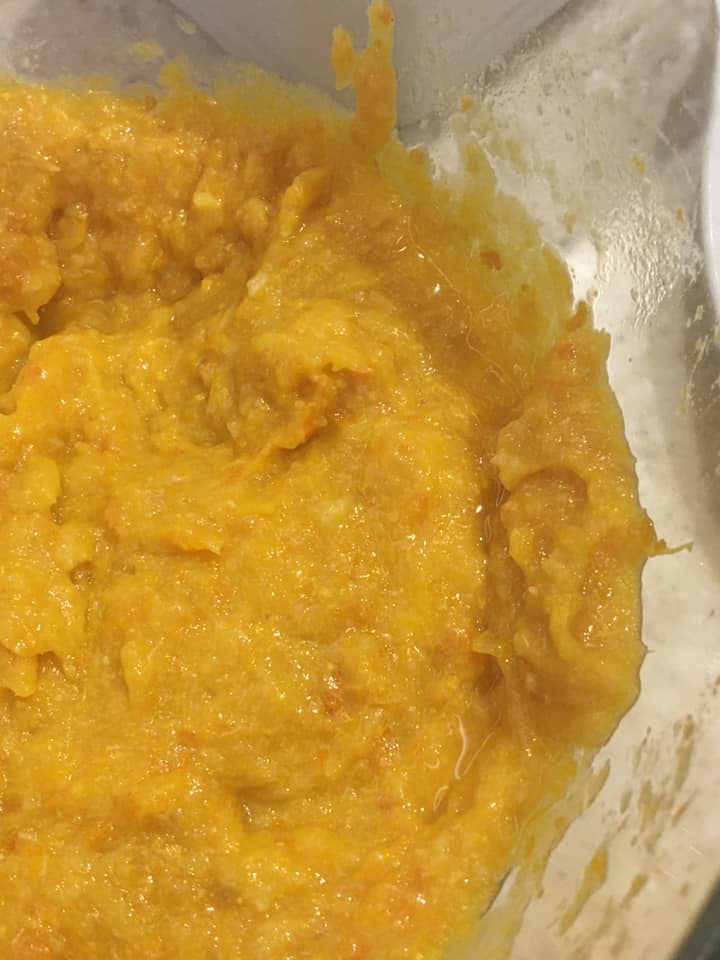
citrus puree ready to be used in all sorts of things
Citrus Scones
I used some of the puree to make some delicious scones, without using an egg, so would be vegan. Recipe on the FB post.
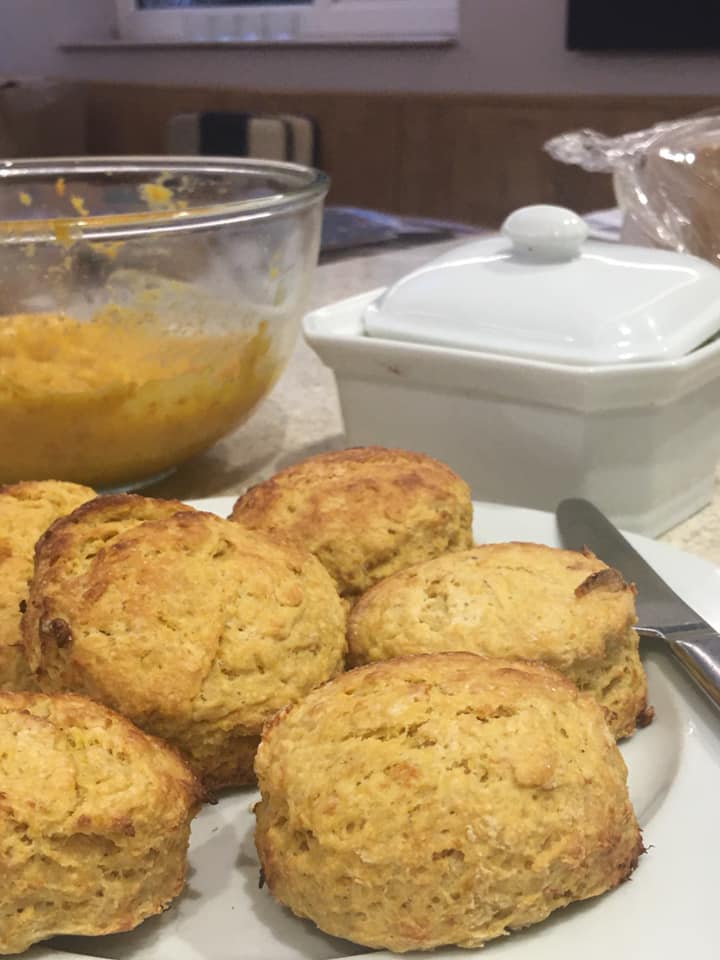
citrus scones
Citrus Greek Yogurt
Then added some to thick Greek yogurt, which was very yum. I used 1 tblsp puree to 100g yogurt, with 1 tsp sugar.
Marmalade
Then the last of it was used to make a pot of marmalade. I put 180g of puree in a thick based saucepan, added 180g granulated sugar and brought to the boil. I let it blip for a couple of minutes then put it into a sterilised jam jar. Made exactly 1 jam jar. Tastes delicious, not exactly like marmalade from the shop as it is made differently, but very good
Leftover Lemon Peel
Leftover lemon peels, those from lemons you’ve zested and juiced, can be used to make a fresh and zingy lemon syrup.
Or if you’ve juiced a lemon, make preserved lemons with them. An incredibly useful condiment to have in the larder.
If you are using a fresh lemon for juice, make sure to zest it first. Keep the zest in a small freezer box, ready for all those times a little zest would be good
If you’re using a fresh lemon just for the zest (and you don’t have any stashed in the freezer) make sure to juice the lemon and freeze the juice for when you need it. Also freeze the carcass for later use.
Once a lemon has been zested and juiced, pop the carcass into the freezer to use later. Keep all your squeezed carcasses together.
With all these little bits and pieces potentially being frozen – don’t forget the label! We’ve all taken something out of the freezer thinking it was one thing when it was quite another.
Pith
This Greek recipe for Spoon Fruit uses just the pith from lemons
Or you can make your own pectin using the pith
Pips
The pips from a lemon can be used very simply to make pectin for your preserves. You can put them in a saucer in a little water overnight when they will form a gel that can be used in your preserves. Or use them direct in the preserving pan, tied in a little muslin
I had no idea lemon pips could be used this way, indeed in any way other than planting in a little pot! Which admittedly is fun. You get a pretty little plant, which if you are really lucky, may even grow you a lemon
When you use a lemon, pop the pips into a small freezer container kept specially for the purpose, so they are there when you want them
Pectin
Pectin is actually a healthful thing to consume, reducing blood LDL cholesterol levels.
If you want to, you can use the Pith to make your own Pectin
Limes
I’ll write something about limes later – so, to come
Grapefruits
Grapefruit peel too can be used to make pectin. Or you could dry the skin and grind it up to sprinkle on your morning yogurt
Grapefruit pith is very rich in antioxidants and nutrients and also soluble fiber which is going to help you feel fuller and impact your glucose reactions,” says Delbridge.
So, lots of ideas on what to do with peelings, pith and pips. I was throwing away all these things until I started writing this – although I was simmering the carcasses and finding the resulting pulp extremely useful!




Mimi – shame the family doesn’t like it, but as you say, with a choice between them doing the cleaning or using the economical cleaner – someone else cleaning wins every time!
Mimi – it’s simply amazing sometimes what we can make with nothing much at all isn’t it!
Hello again, I make the orange peel/vinegar cleaner mixture and love it, sadly my family don’t. I use it but when they clean surfaces etc they insist on using branded cleaners. Totally unnecessary in my opinion but if they are prepared to do the cleaning who am I to object! I will be trying the candied peel recipe too……would love to have a taste of the ones in your pictures – they look irresistible.
Hi Lesley, last year I had several satsumas, oranges and lemons very very dried up and was reluctant to throw them away (being thrifty like you). I decided to experiment! I just gave the whole lot a really good scrub, cut them up small and removed the pips. I thought the result would be lacking in full flavour so bought (reduced price) orange extract to zing it up a bit. I needn’t have worried, the fantastic flavour of the “marmalade” was like nothing I have ever experienced before. I got 3 jars from it and although a little over set was wonderful!!! Sadly, I didn’t note down the exact method I used, so maybe not be able to recreate it but this was a great lesson for me, to think twice before throwing anything away.
Thanks a bundle, Lesley! My English husband will likely love them if they taste of marmalade. ;>}
Hi Gia, I do indeed need to post that recipe, but until I do. here’s the recipe (copied from the FB post)
I had some zested and juiced lemon halves, some dried up lemons and some dried and wrinkled clementines
I bunged the whole lot in a saucepan and simmered them in a little water until tender, then removed the pips and blitzed. Result was tasty, but I didn’t really know what to do with it.
Options included an almond cake or a fruit curd. But I opted to try it in scones
This is the result and they’re extreme tasty! The flavour is a little like they have marmalade in. I made them without egg and added gram flour. They’re a little denser than I’d like, so I’ll try adding more baking powder next time. Still quite a lot left.
I tipped the remaining cooking liquid away, but am now wondering if it could be used in some way, perhaps like pectin?
Wonder if you could use all waste – eg orange peel, squeezed and zested lemons. I’m going to try it, nothing to lose! (I have since used just zested and squeezed carcasses and it works just fine)
We ate one whilst still warm, and that was a little too dense. But once cooled, the texture was just fine
I used
150g self raising flour
50g butter
40g gram flour – for an egg
25g sugar
200g of the citrus purée
Cut into 6 scones. Baked at 200c fan for 20 minutes
Hi Lesley, Love that you are spreading the word about sparing citrus peel and using it to good advantage in the kitchen! I’m happy to use it rather than relegate it to the compost pile.
I am not on FB but would love to try your recipe for orange scones made with the peel puree. (I’m vegan and it’s difficult to bake without eggs and regular butter, and I take it that the pectin in the peels stands in for egg.) Is there any chance you could post the recipe here on your blog as well?
Thank you Angela.
How wonderful to have all that lovely citrus available. I take it you aren’t in the UK!
I have an orange tree and two mandarin trees dripping with fruit. My friend has a lemon tree and my neighbour has a lime tree….sometimes it does get to be a bit too much : ) Yes I do give lots away : )
Thanks for the lovely recipes Lesley.
Glad you like it
Wonderful ways to fully use citrus!
I’ll be doing some of these.fantastic ideas thankyou x